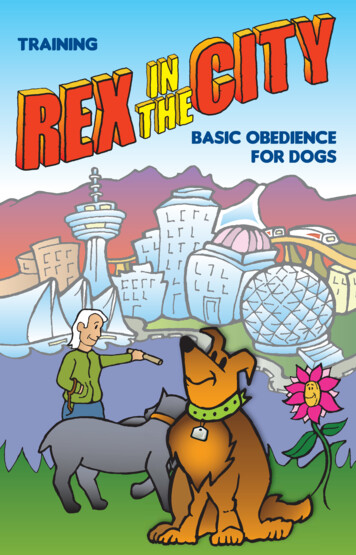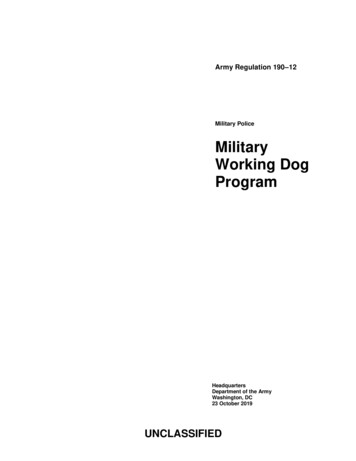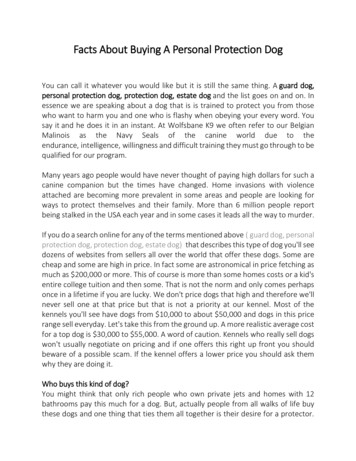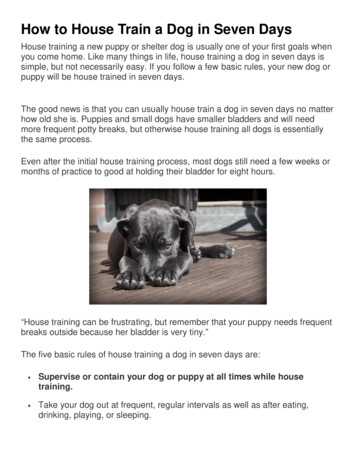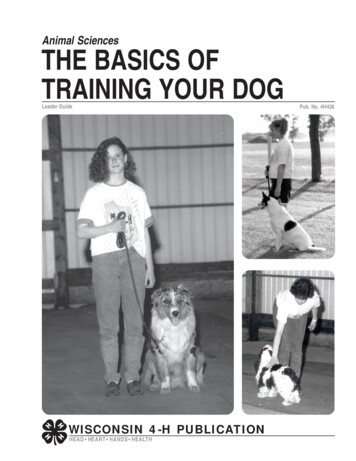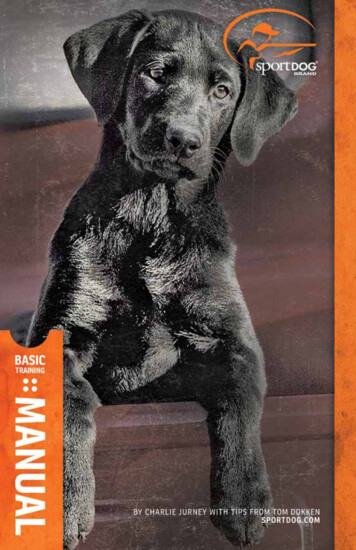
Transcription
SPORTDOG.COM
IMPORTANTCONTENTSDON’T USE YOUR COLLAR BEFORE READING THIS MANUAL.DOING SO COULD CAUSE PROBLEMS THAT WILL MAKE ITMORE DIFFICULT TO TRAIN YOUR DOG. YOU’LL NEED TOCHARGE THE COLLAR AND TRANSMITTER BEFORE FIRSTUSE. WE RECOMMEND READING THIS MANUAL DURING THECHARGING TIME.WELCOME01LEARNING TO TRAIN02THE ELECTRONIC COLLAR06TRAINING YOUR DOG07UNDERSTANDING CORRECTION17PRESENTING NEW TRAINING CHALLENGES18APPLICATION OF THE ELECTRONIC COLLAR21ABOUT THE AUTHORS29
will become more challenging. No matter what phase of training you’re in,attitude should always be top of mind. This is one of the most important wordsI will mention. First, your attitude toward your dog should be very positive anddirect without a lot of unnecessary chatter. Straightforward, one-word, simplecommands will make your dog’s job easier. As important as your attitude is, yourdog’s attitude requires the most attention. If your dog is walking around withhead down and tail tucked, you need to back off and slow down. There will be afair amount of mental pressure during this program. Most folks think of physicalpressure during training, but in reality, most of the pressure your dog feels will bemental. When this occurs, I’ll explain to you how to relieve that pressure and getthe tail wagging again. A happy dog learns faster, so make sure both you and yourdog’s attitudes are positive.OK, let’s get started with turning this business of dog training into part of yourdaily routine.LEARNING TO TRAINWELCOMEFew things are more rewarding than setting a performance goal for your dog andaccomplishing that goal as a team. In this manual I’m going to lead you, step bystep, to a successful result: An obedient dog that loves to work and be with you.There’ll be frustrating training sessions where nothing goes as planned, but aslong as you keep your focus, you’ll reach your goal.Electronic training is safe. No harm will come to your dog if you follow the stepsI set up for you. This program is built on more than 20 years of success withvirtually every breed. Many people are concerned e-training will cause their dogto dislike them or lose its happy and playful attitude. This won’t happen if youfollow two very important rules:1.Follow the steps in the order I’m presenting them. Don’t jump ahead.2.Be careful about accepting outside coaching or information. Thereare many good professional trainers capable of training your dog,and they have their own programs, but their methods may notbe compatible with this one. And, many well-meaning but lessexperienced folks will toss out information that may not be best foryou or your dog.To be sure, the beta dogwill present regularchallenges in hopes ofgaining the alpha position.If the beta dog wins thechallenge, there’s a newleader of the pack , sodon’t give in. Some of thechallenges are subtle.Those are the ones youmust pay close attentionto while training. If youwin the small battles, thebig fights will be mucheasier to handle. Dogssee the world in blackand white. To your dog,either you’re in controlor it is. There is no middleground.01/02When finished with this training, you and your dog should be able to comfortablyface most any distraction while you maintain total control. We'll start with verysimple goals in our training sessions and move forward at a pace prescribedby your dog, not a timetable. Initially, you'll learn to properly use a leash, andthen progress to verbal commands and obedience drills. Only after these skillshave been mastered will you start using the e-collar. From there, the lessonsEvery animal on the planet has an alpha or beta relationship with every otheranimal. We usually think of “beta” as submissive and beaten down, but in wildpacks or herds, that’s not the case. The beta dog in a pack of wild dogs is stillquite happy and lives a good life. So, your dog should live the comfortable life –while remaining in the beta position. Your dog will be quite happy being beta, aslong as you show the dog that beta is a good way to live. In dog terms, you are the“alpha,” giving your dog everything it needs to survive. The essentials of food,shelter, and, most importantly, companionship (the pack) are provided by you. Forthose things, your dog will work and be happy as long as you demonstrate that youwon’t submit to challenges.
LEARNING TO TRAINneeds. We could spend a lot of time discussing howdogs communicate, and while that would be helpful,your main focus in listening to your dog will be tounderstand when your dog accepts what is offered.This acceptance could be for reward (doing a goodjob) or correction (making repeated mistakes on acommand that has been conditioned).Dr. Ivan Petrovic Pavlov taught us a lot about dog behavior. Two of his mostimportant points, conditioned responses and substitution, will be the cornerstonesof this training program. Conditioned responses to commands are mandatory fora properly-trained dog. When you explain something one time to a person, he orshe will understand it and quite often give a positive response when questioned onthat topic. Dogs are different in that they trust their instincts implicitly. Instinctshave protected dogs for thousands of years from wild animals and other threats,and those threats still live in their minds today. In your training program, youmust totally condition the responses to the obedience commands to such a degreethat your dog trusts you more than its own instincts. That is a tall order, and youmust take it seriously or you won’t have success. Simple repetition is the onlyway to properly condition a dog. Simple repetition, to the tune of around 1,000repetitions per command, will do this nicely. It might seem like an undoable taskbut if you train consistently, it will take only a short time.Dr. Pavlov also taught us about substitution. This is where we use a stimulus tocause a response and then add another stimulus simultaneously until the secondstimulus evokes the same response as the first. You might remember Dr. Pavlov’swork with ringing the dinner bell as he was feeding his dog. It didn’t take longbefore simply ringing the dinner bell caused the dog to salivate. You’ll use thissame practice in training your dog, beginning with a leash, progressing to words,and then finishing with electrical stimulation. It may sound overwhelming rightnow, but you’ll be successful and your dog will accept this without question, if youfollow the steps.That depends on howwell you want your dogto perform. If you desirea bulletproof, obedientdog, you will need to dotwo 10-minute sessionsof focused work withyour dog each day. Now,that doesn't sound sobad, does it? Duringthose sessions, it'll be allwork and no play time.You’ll praise your dogand reward its positiveresponses, but alwaysmaintain an alpha role.Some of the sessionsmay be shorter than 10minutes, and others maybe longer because eachsession should be goaloriented and those goalsmust be realistic.When you accomplish thedesired goal for that day,stop and celebrate. Avoidthe temptation of tryingto meet tomorrow’s goalsalong with today’s goals,just because you havesome extra time. Thatcan lead to failure. Youalways want to finish asession on a positive noteso your dog will lookforward to coming “backto work” tomorrow.While we’re on the subject of rewards - what’s thebest reward for a job well done by your dog? Manytrainers use food treats, and that method will give yousome success. However, what position do you assumewhen you give your dog a treat? That you're beta. Youmust always strive to maintain an alpha role if you’reto keep your dog’s mind straight. If your dog thinksyou're always alpha and it gets all the good things itneeds in life while being beta, why not accept this roleand live the good life? This sounds like a great gig andthat’s what you want your dog to think. So, if you’re notgoing to use a food treat, how do you reward your dogwhen training sessions are going well? There are twomethods that will satisfy your dog’s needs. First, if it’s a retrieving breed, throw anuninhibited retrieve (fun bumper) for the dog, rewarding its chase instinct. If yourdog has a strong chase instinct, what could be more satisfying? Or, you can simplystroke your dog on the shoulder and watch for the swallow response.The latter method helps you maintain more control and will work for almost everydog. During both of these, you maintain your alpha role while rewarding your dog.Make sure you don’t overdo the rewards or they will lose their effectiveness. Evenice cream tastes bad if you eat it all day long. Hand out your praise when your dogdoes well and do so only until it tells you, “I got it” with a swallow.03/04The intent of this program is to help you communicate with your dog. Thiscommunication is a two-way street. Dogs speak to us in their own language andwe must be able to understand what they are saying if training is to be successful.You don’t need to be a modern-day Dr. Dolittle; a few simple skills will cover yourYour dog will tell you, “I got it boss!” by the simpleaction of swallowing. Again, that acceptance behavioris the same for praise and for correction. When youpraise your dog (by stroking its shoulder) you’ll seethe dog’s swallow response. Your dog has spoken,saying: “I accept your praise.” Continual strokingwon’t gain you anything. Conversely, it will decreasethe effect of future strokes and lessen the sincerity.One of the hardest things you will face is knowingwhen your dog has received enough correction.Once again, you will understand this when yourdog gives you the swallow response. No morecorrection is needed because the dog has acceptedthe correction and openly told the world by stickingits tongue out and swallowing. You probably arenot sure this is true, so go ahead and stroke yourdog on the shoulder and watch for the tongue tocome out, followed by a swallow. It’s that simple.HOW OFTENSHOULD I TRAINMY DOG?
LEARNING TO TRAINYour dog will likely exhibit some other behavior during training that you need tounderstand. All dogs attempt to displace themselves from training at one timeor another by telling you: “Hold on, I’ll get back to you and your commands in aminute.” If you have children, this is easy to understand. When telling a child it’stime to go to bed, most parents will get one of, if not all of the following responses:“I need a drink of water,” or “Let me watch five more minutes of TV,” or “I needto go to the bathroom.” In all of these cases, the child is going to bed but on hisor her terms. This sounds a lot like a dog that knows a command but is hesitantto do it. It tries to put off doing the command with a series of actions, and bydoing so, challenges the alpha position. These displacement actions are subtleand overlooked by many trainers.Displacement behaviortakes five classic formsin canines. During a worksession, yawning, sniffingthe ground, head shaking,scratching, and biting atitself are all methods adog uses to tell you, “Holdon, let me do this first andthen I’ll get back to you.”Let me emphasize, thisis only during your worksessions. If you allowthis to go unchecked,the alpha position isopen for debate andfuture challenges arecoming. Each time oneof these actions occurs,immediately correct thedog (we’ll get into thatlater) and repeat the command. Do not be fooled by your dog when these appear.It’s not an accident but rather a planned and instinctive challenge.On the other hand, don’t nag your dog with a lot of babble or too-soft corrections.This will quickly lead to a dog that turns you off and builds tolerance to any formPressure will be a big part of your dog’s life, not unlike ours. The volume ofpressure and how it’s handled will determine your dog’s attitude. Therefore,when using corrections (verbal, leash tug, or electronic), always use the minimumamount of pressure necessary to obtain the desired response. It’s easy to gooverboard when you've lost your focus and failed to control your emotions, butplease don’t go there. Your dog won’t like you for it and you won’t like yourselfthat night when you go to bed. Stay focused on your goal for the day and yourdog’s body language. Heavy correction may not make the problem go away anyquicker than a few more repetitions. Take the conservative approach of stoppingyour dog’s unwanted actions with the correction while your dog remains focusedon you. Too much correction will cause your dog to lose that focus, and too littlecorrection will not stop the action. You’ll learn how to find that level of correctionshortly, but do not jump ahead. Like all good trainers, be patient.INTRODUCING THE SPORTDOG BRAND ELECTRONIC COLLARIn the manual that came with your remote training system, you will find all theinformation you need to operate it. Please read this and know which button doeswhat, how to turn it off, when the battery is fading, and all the other essentialsthat pertain to this high-tech training system. You have purchased a well-testedand proven piece of equipment. Take good care of it and you’ll get many years ofreliable service from it.When you know how it all works, follow the instructions on how to turn yoursystem on and let’s get going. Place the receiver (collar) snugly around your dog’s05/06During your training sessions, it’s likely that your dog will be overwhelmed inspite of your best efforts to prevent this. Learn from this and watch your dog’sbody language. If you see this body language starting to appear in the future, backoff and go do something fun. Due to improper usage, e-collar training has beenassociated with over-pressurization for many years. You don’t want your dog’shead or tail to be down for an extended period. There will be many times whenyour dog will be timid and show a lack of confidence in training. This is quitenormal when the lessons are new and unconditioned. You were probably the sameway when you went to your job for the first few days. Be patient with your dog andwork through the uncertain times with an extra stroke on the shoulder and a kindword.of correction. Many folksA REMINDER ABOUT ATTITUDE:want to use the lightestelectroniccorrectionEarlier, I mentioned the attitude of you and your dog.possible, hoping theyAttitude needs to be addressed each training session. Ifwill not hurt their dog.your dog’s attitude is not good, you need to reevaluateThat sounds polite andwhat is happening. Always ask yourself: 1) Are both of usis a nice thought but mayhappy in what we are doing? 2) Is my dog’s tail wagging?not accomplish anything.Answer these questions each time you train and pay closeUse a level of correctionattention to your dog’s body language. Also, how are you(verbal, leash tug, orfeeling today? Was it a bad day at work? Did you sleepelectrical stimulation)well last night? Is the IRS looking for you? If you do notthat your dog respondsfeel good, take a break until you can present a positiveto in a positive fashionattitude to your dog.(more on this later). YourYour dog will read your body language instantly anddog will progress fasterknow if you are not up to training that day. If you are offand be more reliable inyour game a little, the challenge your dog presents for thethe long run if you arealpha position is likely to be a little more earnest. In otherdirect and honest in yourwords, don’t be afraid to take a day off if you can't givewords and actions. Thisyour dog your best effort.is accomplished by usinga level of cor rec tionthat causes the swallow response of acceptance while your dog remains focusedon you.
THE ELECTRONIC COLLARneck so it stays in place directly behind your dog’s ears. Pull the strap until it’stight, back off one hole in the strap and fasten the collar. You should be able to slipone finger under the strap without any trouble if it’s properly tightened. The collarshould remain in place without your dog struggling to breathe. If the collar slidesdown your dog’s neck or spins out of its original position, you need to tighten it.Both receiver probes must be in contact with your dog’s skin or the unit won’tfunction properly. Congratulations, you have done the hardest part of e-collartraining: You had the courage to take control of your dog’s actions.Now comes another very important point. Each time you place the collar on yourdog, do something fun. Throwing a ball or retrieving toy every time your dogwears the collar is a great way to make your dog think that the collar is a ticket tothe amusement park. One of the quickest ways to have your dog think otherwiseis to put the unit on and push a button. Make the collar your dog’s uniform to dosomething enjoyable by always doing something your dog likes after attaching thecollar. You should do this for the entire life of your dog and not just while training.A word about leashes: There are many types and styles available. I use one basedon the design of a “piggin’ string.” The advantages of this handy little rope aremany. First, it’s a leash and collar all in one. Second, although it works on thesame principle as a pinch or choker collar, there’s a major difference: The momenta dog gives, the lead releases its pressure, which rewards the dog for complying.No pinch or choke collar can respond as quickly. It provides that all-importantinstant reward when your dog complies with your command.How can you give yourdog a dose of bitterobedience and make itthink it tastes like sugar?What does your dog gainout of being obedientthat would encourageits acceptance of thecommands? The answerto both of these questionsis a positive reward.As I mentioned earlier,you should avoid usingfood treats as a reward.A dog that works forfood treats is workingfor itself, and thatmentality encourages itto challenge the alphaposition. Your dog shouldA TRAINING TIP FROM TOM DOKKEN: WHEN CAN I START USINGMY E-COLLAR?One of the most common obedience-training questions I hear is, “How old does my doghave to be for me to use the e-collar?”TRAINING YOUR DOG TO PERFORM THE OBEDIENCECOMMANDSThe better your dog responds to commands while on-leash, the better it will respondwhile wearing the e-collar. Before transitioning from the leash to the e-collar, your dogmust be 100% responsive to all of its obedience commands.Dogs learn at different rates, and if you try to start too early, you'll have a disaster onyour hands. I've seen five-month-old dogs that were ready for the transition to e-collartraining, but I’ve also introduced seven-year-old dogs to the e-collar. In fact, an olderdog that has been performing commands for some time is probably easier to work with.This is one area where the line about “old dogs and new tricks” isn't true.07/08It’s mandatory that you control your dog’s actions during every training session.Initially, controlling your dog during obedience training sessions is accomplishedin two ways: 1) the leash and 2) the tone of your voice. While on the leash, your dogdoes not have an opportunity to escape through the instinctive mechanisms allcanines possess. Bolting, biting, and quitting are no longer options. Your tone ofvoice will later take the place of the leash. Later the e-collar will replace both andyou will be able to put the leash away until you train your next dog.Knowing when your dog is ready for e-collar training is important, but the determiningfactor really isn’t about your dog’s age. You’ve heard it before and now I’m going to sayit again because it’s so important: The e-collar is for reinforcing commands your dogknows. It shouldn't be used to try to teach a dog something.
TRAINING YOUR DOGalways work for you, because you are the most important relationship in its life,and pleasing you should be at the top of its priority list. The positive reward anydog appreciates most from a trainer is a thank you in the form of a loving shoulderstroke, affectionate eye contact, and a sincere, “Good dog.” If your dog doesn'tlight up on any of those three, you need to reevaluate your relationship. Eachcommand should be followed with a positive reward of some fashion when yourdog follows your lead.without deviation. Thiscommand is very easy foryour dog to learn if youspeak its language. Mostdogs make a beeline toany person who kneelsdown and opens up theirarms. In this positionyou are using posturallanguage to welcomeyour dog. While you arekneeling and your dogis running to you, addt h e ve r b a l c o m m a n d“ H e r e .” S h o w e r y o u rdog with positive verbalrewards while strokingits shoulder.THE FIRSTCOMMAND: NOThefirstcommandyour dog will learn is,“No.” Usually your dogwill understand thiscommand by the end ofits first day with you.Your dog hears thiscommand each time it’sdoing something wrongand it comprehends thecommand by the way yousay it. Your dog may havebeen running around thehouse with your wife’spantyhose in its mouthor chewing on your prizeddecoy when it hears thatdreadful word. Intonation expresses your feelings to your dog in a language thatis universal. The tone of your voice tells your dog that it’s in trouble and throughrepetitive use, the word “No” comes to mean the same thing. Voila! Our firstconditioned response! (Thank you, Dr. Pavlov.)“No” means stop what you are doing immediately. Put yourself in your dog’splace when it hears this command and understands it. The dog is thinking it mustquickly stop what it’s doing. Your dog would gladly obey you, if it only knew whatyou desired. For this reason, when your dog does stop doing whatever it was thatbothered you, you must give another command expressing what will please you.“No” is always followed with something that will make you happy. When you arehappy, your dog will see it through your eyes, feel it by your touch, and hear it inyour tone. And, that is your dog’s positive reward. Even when it makes a mistakeand is corrected by the word “No,” it receives a reward by following your nextcommand. This is a simple and foolproof method.THE MOST IMPORTANT COMMAND: HEREThe leash (or lead) should be used in training your dog on the command “Here”as soon as it is comfortable with the leash. Give the command “Here” and apply aslight tug on the leash. Be sure to release the leash pressure the instant the dogstarts coming toward you. Many people try to maintain leash pressure until thedog is at their side. While this works, it can be too much pressure and your dogdoes not get the reward of turning the pressure off while it’s coming to you. If yourdog hesitates or fails to come directly to you, give another tug with the lead andrepeat “Here.”When your dog arrives at your side, stroke its shoulder until it gives you a swallowresponse. Your dog has learned what you want and now it’s time to condition theresponse with repetition.A POSITIONAL COMMAND: HEEL“Heel” is a positional command that instructs your dog to assume a position besideyour leg whether you’re walking, standing, running, or riding a horse. People seekprofessional help in teaching their dog to heel properly more than for any othercommand. These folks always explain that their puppy is a great dog but it will09/10“Here” is the most important command your dog will ever learn. It’s an escapefrom almost any trouble. “Here” tells your dog to come to you immediately andLet’s take a second, again,and discuss how muchpositive reward to give a dog when it follows your commands. Do you rememberhow your dog communicates to you that it understands and accepts your actions?When your dog swallows, it says, “I understand.” So, back off the positive rewardswhen your dog says it understands and accepts your thank you by swallowing.Continually stroking your dog’s shoulder and praising it will eventually lessen thesincerity of your reward and that could be a huge mistake. Training your dog tocome to you with the “Here” command is done along with the postural position ofkneeling and opening up your arms.
TRAINING YOUR DOGnot walk on its leash.This means the dog feelslike it’s alpha and shouldlead its owner where itpleases. Every dog willlearn proper heel positionon its first day of trainingwith proper leash usage.Place the leash in itsproper position behindyour dog’s ears and beginwalking forward. If yourdog attempts to lead youby moving ahead, simplychange direction. Theleash will tighten aroundits neck and it will followyour new direction. It’simperative that no leashpressure be present whenyour dog’s head is besideyour knee. It will learn this position is safe and causes no discomfort throughrepetition. Add the verbal command “Heel” after the dog assumes the correctposition and repeat “Heel” each time its head is beside your knee.We have discussed how to correct your dog if it attempts to lead you, but whatshould you do if it tries to lag behind or flop around like a fish instead of followingyour lead? Keep moving forward and allow the leash to do its job. The importantpoint is for you not to stop moving. If you stop walking to check on your dog orcoax it forward, the leash will relax and its pressure will stop. Your dog mustlearn that the only way the pressure around its neck will disappear is by assumingthe correct “Heel” position. With repetition, this position will become a comfortzone.ANOTHER POSITIONAL COMMAND: SITThe next command to teach is “Sit.” With this command, you tell your dog to sitand remain seated until it receives another command. The leash applies pressureto the underside of the dog’s neck when you are training it to sit. You are nowworking on a different pressure point. Pull straight up on the lead with your righthand and push down on your dog’s butt with your left hand, until its bottom hitsthe ground. Add a verbal “Sit” and release the pressure on the leash. Pressurefrom the leash can be omitted when your dog is consistently sitting on verbalcommands. Later you will get into corrections and the steps you should followto make things clear for your dog. Repeat the “Sit” drill until your dog is happilydriving nails with its rear.up on the leash until your dog sits in a proper fashion.It may become necessary to step forward if your dogwill not align itself properly at first. Fight for theproper sit position now and you won’t have to addressthis in the future when you are asking it to sit in theface of overwhelming distractions.Now your dog has learned to come to you, walkcomfortably beside you, and sit on command. It mustconcentrate and use its brain as it learns these skills.Pay close attention to your dog’s focus, making surethat the training sessions are not too long. Eventhough your dog’s brain is a sponge at this point, itcan become oversaturated and unable to receive anymore constructive information.Have you ever seen a dogthat won’t listen when it'snot wearing an e-collar?That dog is what wecall “collar-wise.” Theproblem starts when adog misbehaves and theowner responds by onlythen strapping on thee-collar. The dog quicklyassociates the e-collarwith punishment andknows that consequencesto misbehavior can onlyhappen when that collar isaround its neck.Luckily, the collar-wiseproblem is easy toavoid through “preconditioning.” This simplymeans that you placethe e-collar on your dogevery time you go to dosomething that the dogassociates with fun orfreedom. This happenseven before seriousobedience trainingbegins and long beforeyou actually turn on thee-collar.Because your dog willeventually associate thee-collar with being freeand loose, it will neverknow the e-collar is thesource of discipline.11/12Have you ever seen a dog sit sideways? It flops down and comes to rest on onehip. This is a common occurrence for lazy dogs and needs to be corrected. PullA TRAININGTIPFROM TOMDOKKEN:DON’T CREATE A“COLLAR-WISE”DOG
TRAINING YOUR DOGWhat should you do if your dog decides it does notwant to enter? You know it will give to the pressure ofa leash, so lead it into the proper area and command“Kennel.” Once in the correct place, stroke pup on theshoulder until you see acceptance via the swallowresponse. Repeat this routine until you start todevelop a conditioned response to your command.Some dogs fight this entry with a great deal of vigor.If your dog chooses this option, be sure to maintainleash pressure until you get the desired response.Once it understands that there is no danger in theseareas, it will be glad to enter upon command.A FOLLOW-UP TO “SIT”: STAYWhen you give your dog the sit command, you’ve told it to sit and remain seateduntil it receives another command. Many obedience programs no longer use the“Stay” command, believing it is redundant and not necessary. However, it wouldbe good for you to know how to condition for this command if your dog struggleswith remaining sitting. To reinforce sitting, apply a light amount of upward leashpressure to its collar and command “Stay” as you start to move away and towardthe end of the leash. Your dog will likely get up and try to move with you. If thisoccurs, stop it with “No,” reseat the dog with “Sit” and repeat “Stay” with anotherupward tug on the leash. It should not take too many corrections before yourdog figures this puzzle out. Should it continually refuse to stay, add increasingamounts of leash pressure and stronger “No” commands until it obeys. You mayneed to be more patient here than any other place. You have already conditionedyour dog to move with you at heel as you move away and many dogs think this iswhat you want now instead of remaining seated. Correction for mistakes, rewardsfor positive responses, and repetition will quickly condition your dog to thiscommand.A DIRECTIONAL COMMAND: KENNELI am willing to bet thatmost people use ane-collar to reinforcethe recall or “Here”command more thanany other obediencecommand. As a result,they often work on thatcommand more thanthe others. But keep inmind that if you spenda lot of time on a singlecommand, and thenyou try to commandsomething else, yourdog may respond withthe action it’s mostcomfortable with.An example of thiswould be an uplandhunting dog that will notget out and hunt in frontof its owner be
TRAINING YOUR DOG 07 UNDERSTANDING CORRECTION 17 PRESENTING NEW TRAINING CHALLENGES 18 APPLICATION OF THE ELECTRONIC COLLAR 21 ABOUT THE AUTHORS 29 CONTENTS. will become more challenging.No matter what phase of training you’re in, attitude should always be top of mind.
